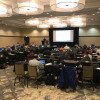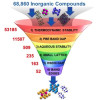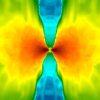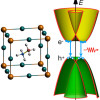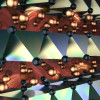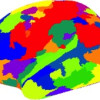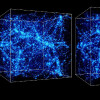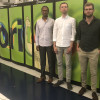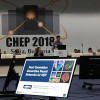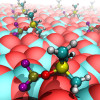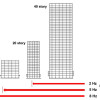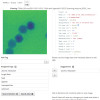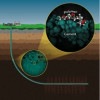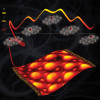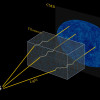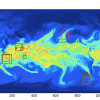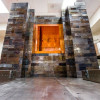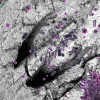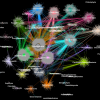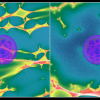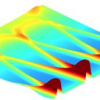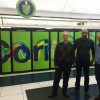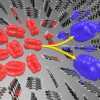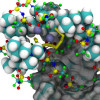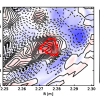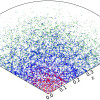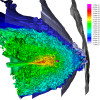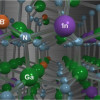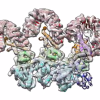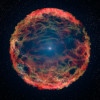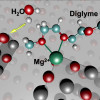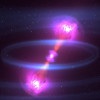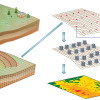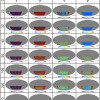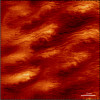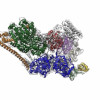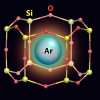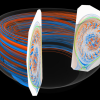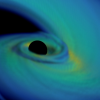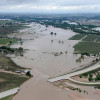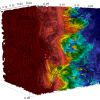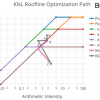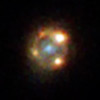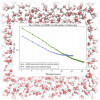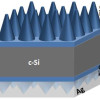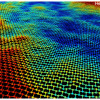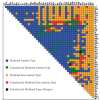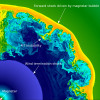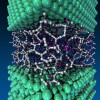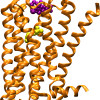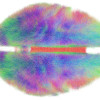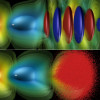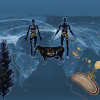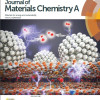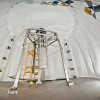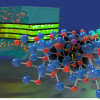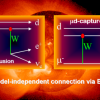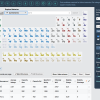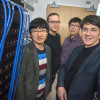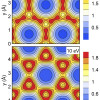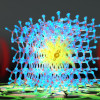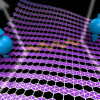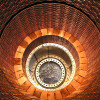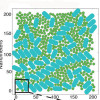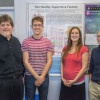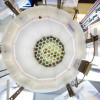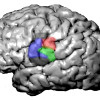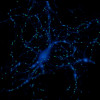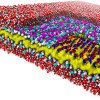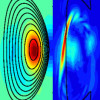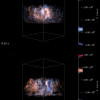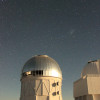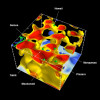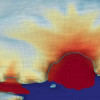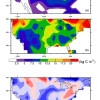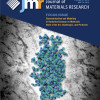Science News
2019 DOE Performance Portability Meeting Breaks New Ground
The 2019 DOE Performance, Portability, and Productivity Annual Meeting once again brought together representatives from national labs, academia, and the vendor community to share ideas, progress, and challenges in achieving performance portability across DOE’s current and future supercomputers. Read More »
Searching for Photocathodes that Convert CO2 into Fuels
As scientists search for new materials to enable the photocatalytic conversion of CO2, a Berkeley Lab team used supercomputing resources at NERSC to perform a massive photocathode search, starting with 68,860 materials and screening them for specific intrinsic properties. Read More »
When Stars Collide: 3D Computer Simulation Captures Cosmic Event
The aftermath of the collision of two neutron stars has been fully captured in a 3D computer model for the first time, thanks to research by University of Alberta astrophysicist Rodrigo Fernández and an international team. Read More »
Revealing Reclusive Recombination Mechanisms in Solar Cell Materials
Researchers at UCSB used NERSC supercomputers to better understand key mechanisms behind the solar conversion efficiencies of hybrid perovskites, which could make these materials even more attractive for photovoltaics. Read More »
Shedding New Light on Luminous Blue Variable Stars
Three-dimensional simulations run at NERSC, Argonne and NASA have provided new insights into the behavior of a unique class of celestial bodies known as luminous blue variables - rare, massive stars that can shine up to a million times brighter than the Sun. Read More »
Simulations Run at NERSC Confirm Thermal and Electrical Properties of Superionic Crystals
Using a combination of experiments and simulations, materials scientists at Duke University, Oak Ridge National Laboratory and Argonne National Laboratory have sussed out the physical phenomenon underlying the promising electrical and thermal properties of a class of materials called superionic crystals. Read More »
Berkeley Lab, Oak Ridge, NVIDIA Team Breaks Exaop Barrier With Deep Learning Application
A team of computational scientists from Berkeley Lab and Oak Ridge National Laboratory and engineers from NVIDIA has, for the first time, demonstrated an exascale-class deep learning application that has broken the exaop barrier. Read More »
HP-CONCORD Paves the Way for Scalable Machine Learning in HPC
A team of Berkeley Lab researchers has demonstrated how a new parallel algorithm called HP-CONCORD can help address some of the most challenging problems in data-driven science. Read More »
NERSC, Intel, Cray Harness the Power of Deep Learning to Better Understand the Universe
A Big Data Center collaboration between computational scientists at NERSC and engineers at Intel and Cray has yielded another first in the quest to apply deep learning to data-intensive science: CosmoFlow, the first large-scale science application to use the TensorFlow framework on a CPU-based high performance computing platform with synchronous training. Read More »
Topology, Physics & Machine Learning Take on Climate Research Data Challenges
Two PhD students who first came to Berkeley Lab as summer interns in 2016 are spending six months a year at the lab through 2020 developing new data analytics tools that could dramatically impact climate research and other large-scale science data projects. Read More »
Berkeley Lab Researchers Showcase Deep Learning for High Energy Physics at CHEP
Steve Farrell, a machine-learning engineer who recently joined NERSC, gave an overview of Berkeley Lab’s expanding expertise in deep learning for science during a plenary talk at the 2018 CHEP conference in July. Read More »
Batteries Get a Boost from ‘Pickled’ Electrolytes
Battery researchers at Argonne National Laboratory used computer simulations to help reveal the mechanism behind a common additive known to extend the life of lithium-ion batteries. Read More »
Berkeley Lab-Developed Digital Library is a Game Changer for Environmental Research
Developed by Berkeley Lab, NERSC and NCEAS researchers, ESS-DIVE is a new digital archive that serves as a repository for hundreds of U.S. Department of Energy-funded research projects under the agency’s Environmental System Science umbrella. Read More »
IceCube Neutrinos Point to Long-Sought Cosmic Ray Accelerator
An international team of scientists has found the first evidence of a source of high-energy cosmic neutrinos, ghostly subatomic particles that can travel unhindered for billions of light years from the most extreme environments in the universe to Earth. Read More »
NOvA experiment sees strong evidence for antineutrino oscillation
The Fermilab NOvA neutrino experiment announced that it has seen strong evidence of muon antineutrinos oscillating into electron antineutrinos over long distances, a phenomenon that has never been unambiguously observed. Image: Sandbox Studio Read More »
New Simulations Break Down Potential Impact of a Major Quake by Building Location and Size
A team of Berkeley Lab and LLNL researchers is leveraging powerful supercomputers at NERSC to portray the impact of high-frequency ground motion on thousands of representative different-sized buildings spread out across the California region. Read More »
Berkeley Researchers Use Machine Learning to Search Science Data
Science Search, a web-based search engine for scientific data is currently being developed by a team of researchers in Berkeley Lab's CRD and NERSC. The team is also developing innovative machine learning tools to pull contextual information from scientific datasets and automatically generate missing metadata tags for each file. As a proof-of-concept, the team is working with staff at the Molecular Foundry, to demonstrate the concepts of Science Search on the images captured by the facility's instruments. Read More »
Self-Healing Cement Could Be a Boon to Oil & Gas Industry
Researchers at Pacific Northwest National Laboratory have developed a unique cement that can repair itself in as little as a few hours; simulations run at NERSC helped them understand how it works. Read More »
Quarterbacking Catalysts by Positioning Atoms
Materials science researchers at Pacific Northwest National Laboratory used experiments involving graphene, along with calculations run at NERSC, to better understand how oxygen atoms bind with graphene and turn graphene into a unique catalytic support. Read More »
Tiny Distortions Reveal Clearer Picture of Strands in Cosmic Web
Scientists have decoded faint distortions in the patterns of the universe’s earliest light to map huge tubelike structures invisible to our eyes – known as filaments – that serve as superhighways for delivering matter to dense hubs such as galaxy clusters. Read More »
Deep Learning at 15 PFlops Enables Training for Extreme Weather Identification at Scale
Petaflop per second deep learning training performance on the Cori supercomputer at NERSC has given climate scientists the ability to use machine learning to identify extreme weather events in huge climate simulation datasets. Read More »
Underground Neutrino Experiment Could Provide Greater Clarity on Matter-Antimatter Imbalance
A new underground neutrino experiment could provide greater clarity on matter-antimatter imbalance in the Cosmos. And NERSC will be the principal site for data processing and analyses throughout the course of the experiment. Read More »
NERSC Supercomputers Help Researchers Create Reference Catalog for Rumen Microbiome
Using supercomputers at NERSC, an international team led by William Kelly, formerly at AgResearch New Zealand’s Grasslands Research Centre, and including scientists at the Joint Genome Institute generated a reference catalog of rumen microbial genomes and isolates cultivated and sequenced from the Hungate1000 collection. Read More »
A Game Changer: Metagenomic Clustering Powered by HPC
A team of researchers from Berkeley Lab's CRD and JGI took one of the most popular clustering approaches in modern biology—the Markov Clustering algorithm—and modified it to run quickly, efficiently and at scale on distributed-memory supercomputers. Read More »
Can Strongly Lensed Type Ia Supernovae Resolve One of Cosmology’s Biggest Controversies?
Using the SciDAC developed SEDONA code and NERSC supercomputers, astrophysicists at Berkeley Lab and the University of Portsmouth discovered how to control the effects of "micolensing." Armed with this knowledge they believe they will be able to find 1000 strongly lensed Type Ia supernovae in real-time from LSST data--that's 20 times more than previous expectations. Read More »
The Atomic Dynamics of Rare Magneto-Electric Matter
By ricocheting neutrons off the atoms of yttrium manganite (YMnO3) heated to 3,000 degrees Fahrenheit, researchers have discovered the atomic mechanisms that give the unusual material its rare electromagnetic properties. Their work included quantum simulations run at NERSC. Read More »
Physics Data Processing at NERSC Dramatically Cuts Reconstruction Time
In a recent demonstration project, physicists from Brookhaven National Laboratory and Berkeley Lab used the Cori supercomputer to reconstruct data collected from a nuclear physics experiment, an advance that could dramatically reduce the time it takes to make detailed data available for scientific discoveries. Read More »
Delivering Efficient Parallel I/O with HDF5 on Exascale Computing Systems
In an interview with Department of Energy's ECP communications team, Berkeley Lab's Suren Byna and Quincey Koziol talk about delivering efficient parallel I/O with HDF5 on exascale computing systems. Read More »
Berkeley Lab Physicists Apply Machine Learning to the Universe’s Mysteries
Berkeley Lab physicists and their collaborators have demonstrated that computers are ready to tackle the universe’s greatest mysteries – they used neural networks to perform a deep dive into data simulating the subatomic particle soup that may have existed just microseconds after the big bang. Read More »
Charting a New Course in Organic Solar Cell Design
Scientists have pinpointed the source of an ultrafast and efficient process that spawns several carriers of electrical charge from a single particle of light in organic crystals that are integral to this increasingly popular form of solar cells. Read More »
Coupling Experiments to Theory to Build a Better Battery
A research team led by Berkeley Lab found that a new lithium-sulfur battery component allows a doubling in capacity compared to a conventional lithium-sulfur battery. Read More »
The Blob that Ate the Tokamak
Scientists at Princeton Plasma Physics Laboratory used NERSC resources to create new simulations that could provide insight into how blobs (bubbles) at the plasma edge in a tokamak reactor behave. Read More »
Creating a World of Make-Believe to Better Understand the Real Universe
Seeing is believing, or so the saying goes.And in some cases, a world of make-believe can help you realize what you’re actually seeing, too.Scientists are creating simulated universes, for example – complete with dark matter mock-ups, computer-generated galaxies, quasi quasars, and pseudo supernovae – to better understand real-world observations.Their aim is to envision how new Earth-based and space-based sky surveys will see the universe, and to help analyze and interpret the vast… Read More »
Heavy Metal: How First Supernovae Altered Early Star Formation
An international team of researchers ran multi-scale, multi-physics 2D and 3D simulations at NERSC to illustrate how heavy metals expelled from exploding supernovae helped the first stars in the universe regulate subsequent star formation and influence the appearance of galaxies in the process. Read More »
High-Performance Computing Cuts Particle Collision Data Prep Time
For the first time, scientists have used high-performance computing to reconstruct the data collected by a nuclear physics experiment—an advance that could dramatically reduce the time it takes to make detailed data available for scientific discoveries. Read More »
NERSC Resources Help Predict New Material for High-Power, High-Efficiency LEDs
Using predictive atomistic calculations and high-performance supercomputers at NERSC, University of Michigan researchers found that incorporating the element boron into the widely used InGaN (indium-gallium nitride) material can keep electrons from becoming too crowded in LEDs, making the material more efficient at producing light. Read More »
Detailed View of Immune Proteins Could Lead to New Pathogen-Defense Strategies
Researchers at Berkeley Lab and UC Berkeley used cryo-electron microscopy to capture a high-resolution image of a protein ring called an “inflammasome” as it was bound to flagellin, providing new insight into potential strategies for protection from pathogens. Read More »
Deep Learning for Science: A Q&A with NERSC’s Prabhat
In this Q&A with Prabhat, who leads the Data and Analytics Services Group at NERSC and has been instrumental in several projects exploring opportunities for deep learning in science, he talks about the history of deep learning and machine learning and the unique challenges of applying these data analytics tools to science. Read More »
The Mystery of the Star That Wouldn’t Die
Supercomputers at NERSC helped an international team of scientists decipher one of the most bizarre spectacles ever seen in the night sky: A supernova that refused to stop shining, remaining bright far longer than an ordinary stellar explosion. What caused the event is puzzling. Read More »
Solving a Magnesium Mystery in Rechargeable Battery Performance
Simulations run at NERSC helped a research team at the Joint Center for Energy Storage Research discover a surprising set of chemical reactions involving magnesium that degrade battery performance even before the battery can be charged up. Read More »
Scientists Decode the Origin of Universe’s Heavy Elements in the Light from a Neutron Star Merger
Scientists have obtained the first measurement of the merger of two neutron stars and its explosive aftermath. Computer simulations at NERSC were critical for understanding the event, which could provide valuable insights into the origin of universe’s heavy elements. Read More »
Assessing Regional Earthquake Risk and Hazards in the Age of Exascale
Researchers from Berkeley Lab, Lawrence Livermore Lab and UC Davis are using supercomputers at NERSC to build the first-ever end-to-end simulation code to precisely capture the geology and physics of regional earthquakes, and how the shaking impacts buildings. Read More »
A TOAST for Next Generation CMB Experiments
Computational cosmologists at Berkeley Lab they recently achieved a critical milestone in preparation for upcoming CMB experiments: scaling their data simulation and reduction framework TOAST to run on all 658,784 Intel Knights Landing Xeon Phi processor cores on the NERSC’s Cori. The team also implemented a new TOAST module to simulate the noise introduced when ground-based telescopes look at the CMB through the atmosphere. Read More »
Multiscale Simulations Help Predict Unruly Plasma Behavior
New multiscale gyrokinetic simulations are making it easier to more accurately predict plasma behavior in a tokamak reactor. Read More »
NERSC Supercomputers Help Berkeley Lab Scientists Map Key DNA Protein Complex
Using cryo-electron microscopy and supercomputing resources at NERSC, Berkeley Lab scientists have obtained 3-D models of a human transcription factor at near-atomic resolutions. Read More »
A First: Trapping Noble Gases in 2D Porous Structures at Room Temp
A materials science breakthrough at the nanoscale could lead to better methods for capturing noble gases, such as radioactive krypton and xenon generated by nuclear power plants. Read More »
Simulations Show How Recycled Atoms Boost Plasma Turbulence
Using NERSC's Edison supercomputer, physicists at Princeton Plasma Physics Laboratory have modeled how recycled neutral atoms, which arise when hot plasma strikes a tokamak fusion reactor’s walls, increase plasma turbulence driven by what is called the “ion temperature gradient.” Read More »
New Simulations Could Help in Hunt for Massive Mergers of Neutron Stars, Black Holes
Working with an international team, Berkeley Lab scientists have developed new computer models to explore what happens when a black hole joins with a neutron star – the superdense remnant of an exploded star. Read More »
'Hindcasting' Study Investigates the Extreme 2013 Colorado Flood
Using a publicly available climate model, Berkeley Lab researchers “hindcast” the conditions that led to the Sept. 9-16, 2013 flooding around Boulder, Colo. and found that climate change attributed to human activity made the storm much more severe than would otherwise have occurred. Read More »
Record-setting Seismic Simulations Run on NERSC’s Cori System
Record-setting seismic simulations run earlier this year on the Cori supercomputer at NERSC were the subject of two presentations at the ISC High Performance conference in Frankfurt, Germany this week. Read More »
Simulations Pinpoint Atomic-level Defects in Solar Cell Nanostructures
Heterogeneous nanostructured materials are widely used in various optoelectronic devices, including solar cells. However, the nano-interfaces contain structural defects that can affect the performance of optoelectronic devices. Running calculations at NERSC, researchers found the root cause of the defects in two materials and provided design rules to avoid them. Read More »
Record-breaking 45-qubit Quantum Computing Simulation Run at NERSC on Cori
Researchers from ETH Zurich in Switzerland used the Cori supercomputer at NERSC to simulate a 45-qubit circuit, the largest simulation of a quantum computer ever achieved. Read More »
HPC4Mfg Paper Manufacturing Project Yields First Results
Simulations run at NERSC as part of a unique collaboration comprising Berkeley Lab, Lawrence Livermore National Laboratory and an industry consortium could help U.S. paper manufacturers significantly reduce production costs and increase energy efficiencies. Read More »
Roofline Model Boosts Manycore Code Optimization Efforts
A software toolkit developed in Berkeley Lab's Computational Research Division to better understand supercomputer performance is now being used to boost application performance for researchers running codes at NERSC and other supercomputing facilities. Read More »
Rare Supernova Discovery Ushers in New Era for Cosmology
With the help of an automated supernova-hunting pipeline based at NERSC, astronomers have captured multiple images of a gravitationally lensed Type 1a supernova and its host galaxy. This detection is currently the only one of its kind, but astronomers believe that if they can find more they may be able to measure the rate of the Universe’s expansion within four percent accuracy. Read More »
Berkeley Lab Researchers Make NWChem’s Planewave “Purr” on Intel’s Knights Landing Architectures
Berkeley Lab researchers have successfully added thread-level parallelism on top of MPI-level parallelism in the planewave density functional theory method within the popular software suite NWChem. An important step to ensuring that computational chemists are prepared to compute efficiently on next-generation exascale machines. Read More »
Towards Super-Efficient, Ultra-Thin Silicon Solar Cells
Ames Laboratory researchers are developing a highly absorbing ultra-thin crystalline silicon solar cell architecture with enhanced light-trapping capabilities. Read More »
Machine Learning Algorithms Enhance Predictive Modeling of 2D Materials
Researchers from Argonne National Laboratory, using supercomputers at NERSC, are employing machine learning algorithms to accurately predict the physical, chemical and mechanical properties of nanomaterials, reducing the time it takes to yield such predictions from years to months—in some cases even weeks. Read More »
Researchers Catch Extreme Waves with High-Resolution Modeling
Using decades of global climate data generated at a spatial resolution of about 25 kilometers squared, Berkeley Lab researchers were able to capture the formation of tropical cyclones, also referred to as hurricanes and typhoons, and the extreme waves that they generate. Read More »
Machine Learning Accurately Predicts Metallic Defects
Using NERSC supercomputers, Berkeley Lab researchers built and trained machine learning algorithms to predict defect behavior in certain intermetallic compounds with high accuracy. This method will accelerate research of new advanced alloys and lightweight new materials for applications spanning automotive to aerospace and much more. Read More »
Simulations Reveal Invisible Chaos of Superluminous Supernovae
To better understand the physical conditions that create superluminious supernova, astrophysicists are running 2D simulations of these events using supercomputers at NERSC and the Lawrence Berkeley National Laboratory (Berkeley Lab) developed CASTRO code. Read More »
Diamond Shines in Molecular Dynamics Simulations
For centuries diamonds have been revered for their strength, beauty, value and utility. Now a team of researchers from Argonne National Laboratory, running molecular dynamics calculations at the Argonne Leadership Computing Facility and NERSC, are finding additional reasons to celebrate this complex material—and it has nothing to do with color, cut or clarity. Read More »
Simulations Confirm Observations of 2015 India/Pakistan Heat Waves
A paper published December 15 during the American Geophysical Union (AGU) fall meeting in San Francisco points to new evidence of human influence on extreme weather events. Three researchers from Berkeley Lab are among the co-authors on the paper, "The Deadly Combination of Heat and Humidity in India and Pakistan in Summer 2015," which examined observational and simulated temperature and heat indexes and concluded that the two separate heat waves "were exacerbated by anthropogenic climate change." Read More »
Supercomputers Help ID New Drug Leads to Fight Heart Disease
Using a unique computational approach to rapidly sample proteins in their natural state of gyrating, bobbing and weaving, researchers have identified promising drug leads that may selectively combat heart disease. Read More »
Global Brain Initiatives Generate Tsunami of Neuroscience Data
Around the world, various 'Brain Initiatives' are generating a tsunami of neuroscience data. But without a coherent strategy to analyze, manage and understand the data, advancements in the field will be limited. That's why Berkeley Lab's Kristofer Bouchard assembled an international team of interdisciplinary researchers, including NERSC staff, to overcome the big data challenge. Read More »
Multiscale HPC Captures Photovoltaics at the Nanoscale
Advances in ultrafast spectroscopy experiments and high performance computing are revolutionizing the scientific community’s ability to study the physical processes that occur in solar cells at short length and time scales. Read More »
The Incredible Shrinking Particle Accelerator
WarpIV, a new data analysis/visualization toolkit developed at Berkeley Lab, is designed to help speed particle accelerator research and design by enabling in situ visualization and analysis of accelerator simulations at scale. Read More »
Researchers use Edison to Improve Performance, Energy Efficiency of Bioinformatics Application
A team of computer scientists and geneticists from Iowa State University, the University of Maryland and the University of Arkansas have demonstrated significant speedups of the epiSNP bioinformatics program using the Edison supercomputer at NERSC. Read More »
Unveiled: Earth’s Viral Diversity
Researchers from the Joint Genome Institute utilized the largest collection of assembled metagenomic datasets from around the world to uncover over 125,000 partial and complete viral genomes. Read More »
Toward Cost-Effective Polymer Electrolyte Fuel Cells
A research team running density functional theory calculations at Berkeley Lab's NERSC center has demonstrated how polymer electrolyte fuel cells—long favored for transportation applications—can be made to run more efficiently and produced more cost-effectively by reducing the amount of a single key ingredient: platinum. Read More »
World’s Most Sensitive Dark Matter Detector Completes Search
The Large Underground Xenon (LUX) dark matter experiment, which operates beneath a mile of rock at the Sanford Underground Research Facility in the Black Hills of South Dakota, has completed its search for the missing matter of the universe. Read More »
Supercomputers Help Identify Efficiency-Limiting Defects in LEDs
Using state-of-the-art theoretical methods, researchers at the University of California Santa Barbara have identified a class of point defects that act as sites for nonradiative recombination and can explain the observed reduction in efficiency of nitride-based light emitting diodes. Read More »
A Peek Inside the Earliest Moments of the Universe
Researchers from the NPLQCD Collaboration used LQCD calculations to better understand the big bang nucleosynthesis process, which occurred in the first few minutes following the Big Bang, and precisely measure the nuclear reaction rate that occurs when a neutron and proton form a deuteron. Read More »
Cryo-EM’s Renaissance
In a pair of breakthrough Nature papers published last month, researchers in Eva Nogales’ Lab at UC Berkeley mapped two important protein functions in unprecedented detail. And they used supercomputers at NERSC to process and analyze the data. Read More »
Models Help Pinpoint Material for Better Nuclear Fuel Recycling
A team of computational scientists sifted 125,000 molecules to pinpoint one ideal for separating some radioactive gases from spent nuclear fuel, then another team synthesized and tested it. Read More »
New Mathematics Accurately Captures Liquids and Surfaces Moving in Synergy
Berkeley Lab researchers in the Computing Sciences Division have developed a new mathematical framework that allows researchers to capture fluid dynamics at unprecedented detail. The work could be used in a range of applications, like optimizing the shape of a propeller blade and the ejection of ink droplets in printers. Read More »
Materials Project Releases Massive Trove of Battery and Molecule Data
The Materials Project, a Google-like database of material properties aimed at accelerating innovation, has released yet another trove of data to the public that will help researchers working on batteries. Read More »
New Path Forward for Next-Generation Lithium-Ion Batteries
Using supercomputers at NERSC, researchers report a major advance in understanding how oxygen oxidation creates extra capacity “lithium-rich” cathodes, opening the door to batteries with far higher energy density, meaning your phone or electric vehicle will be able to run for much longer between charges. Read More »
Warm Dense Crystallography: Digging Deeper into WDM
Researchers from the University of Washington are using NERSC supercomputers and data from X-ray free-electron laser experiments to gain new insights into warm dense matter (WDM), one of the most challenging aspects of contemporary plasma physics. Read More »
Could Aluminum Nitride Produce Quantum Bits?
The leading method for creating quantum bits, or qubits, currently involves exploiting the structural defects in diamonds. But using NERSC resources, University of Chicago researchers found that the same defect could be engineered in cheaper aluminum nitride. If confirmed by experiments, this could significantly reduce the cost of manufacturing quantum technologies. Read More »
2D 'Flat' Boron Yields a Superconducting Surprise
Density functional theory simulations run at NERSC helped Rice University researchers determine that two-dimensional boron is a natural low-temperature superconductor. Read More »
NERSC Resources Help Find Roots of MJO Modeling Mismatches
Researchers from Pacific Northwest National Laboratory are using field data and NERSC supercomputers to better model how the Madden-Julian Oscillation (MJO) operates and gain new insights into the impact of a warming climate on the MJO. Read More »
Could Material Defects Actually Improve Solar Cells?
Scientists at the National Renewable Energy Laboratory are using supercomputers to study what may seem paradoxical: certain defects in silicon solar cells may actually improve their performance. Read More »
Multi-Scale Simulations Solve a Plasma Turbulence Mystery
Cutting-edge simulations run at NERSC over a two-year period are helping physicists better understand what influences the behavior of the plasma turbulence that is driven by the intense heating necessary to create fusion energy. Read More »
Updated Workflows Enhance New LHC Era
Researchers working on ATLAS, one of the Large Hadron Collider’s largest experiments, are using updated workflow management tools developed primarily by Berkeley Lab researchers to help sift through the increasingly large datasets being generated by the experimental facility. Read More »
Seeing the Big Picture in Photosynthetic Light Harvesting
To understand what goes on inside a beehive, you can’t just study the activity of a single bee. Likewise, to understand the photosynthetic light harvesting that takes place inside the chloroplast of a leaf, you can’t just study the activity of a single antenna protein. So researchers with Lawrence Berkeley National Laboratory and the University of California (UC) Berkeley created the first computational model that simulates the light-harvesting activity of the thousands of antenna proteins… Read More »
Supernova Twins: Making Standard Candles More Standard Than Ever
By employing a new modeling method, members of the international Nearby Supernova Factory based at Berkeley Lab were able to dramatically reduce the scatter in supernova brightnesses. Read More »
Physicists ID Mechanism that Stabilizes Plasma in Tokamaks
A team of physicists has discovered a mechanism that prevents the electrical current flowing through fusion plasma from repeatedly peaking and crashing, which can cause instabilities within the plasma's core. Read More »
World’s Most Sensitive Dark Matter Detector Gets an Upgrade
The Large Underground Xenon (LUX) dark matter experiment, which operates nearly a mile underground at the Sanford Underground Research Facility, has already proven to be the most sensitive detector in the hunt for dark matter. Now, a new set of calibration techniques employed by LUX scientists has again dramatically improved the detector’s sensitivity. Read More »
NERSC, Berkeley Lab Explore Frontiers of Deep Learning for Science
A collaborative effort at Berkeley Lab is applying deep learning software tools developed for supercomputing environments to “grand challenge” science problems running computations at NERSC. Read More »
Supercomputers Speed Search for New Subatomic Particles
A team of theoretical high-energy physicists in the Fermilab Lattice and MILC Collaborations has published a new high-precision calculation that could significantly advance the indirect search for physics beyond the Standard Model. The calculation applies to a particularly rare decay of the B meson (a subatomic particle), which is sometimes also called a “penguin decay” process. Read More »
‘Sidecars’ Pave the Way for Concurrent Analytics of Large-Scale Simulations
A new software tool developed through a multi-disciplinary collaboration at Berkeley Lab allows researchers doing large-scale simulations at the NERSC and other supercomputing facilities to do data analytics and visualizations of their simulations while the simulations are running. Read More »
New ‘Design Rule’ Paves Way for Nature-Inspired Nanostructures
Berkeley Lab researchers have discovered a design rule that enables a recently created material--peptoid nanosheets--to exist. This never-before-seen design rule could be used to piece together complex nanosheet structures and other peptoid assemblies such as nanotubes and crystalline solids. Read More »
What Causes Electron Heat Loss in Fusion Plasma?
A research team led by Princeton Plasma Physics Laboratory has proposed an explanation for why the hot plasma within tokamaks sometimes fails to reach the required temperature, even as researchers pump beams of fast-moving neutral atoms into the plasma in an effort to make it hotter. Read More »
What Ignites a Neutron Star?
Supercomputers at NERSC helped set the stage for astrophysicists from Stony Brook University, Los Alamos National Laboratory and Lawrence Berkeley National Laboratory to perform the first detailed 3D simulation of an X-ray burst. Read More »
Celeste: A New Model for Cataloging the Universe
A Berkeley Lab-based research collaboration of astrophysicists, statisticians and computer scientists has developed Celeste, a new statistical analysis model designed to enhance one of modern astronomy’s most time-tested tools: sky surveys. Read More »
CT Scan of Earth Links Mantle Plumes with Volcanic Hotspots
University of California, Berkeley, seismologists have produced for the first time a sharp, 3D scan of Earth’s interior that conclusively connects plumes of hot rock rising through the mantle with surface hotspots that generate volcanic island chains like Hawaii, Samoa and Iceland. Read More »
Ice Sheet Model Reveals Most Comprehensive Projections for West Antarctica’s Future
A new international study is the first to use a high-resolution, large-scale computer model to estimate how much ice the West Antarctic Ice Sheet could lose over the next couple of centuries, and how much that could add to sea-level rise. Read More »
Land Management Practices More Critical as Biofuels Use Grows
The handling of agricultural crop residues appears to have a large impact on soil's ability to retain carbon, making land management practices increasingly important, especially under a scenario where cellulosic materials become more heavily used as a feedstock for ethanol production, according to a study led by researchers at the U.S. Department of Energy’s Argonne National Laboratory. “Plants and soil are carbon sinks,” said Argonne climate scientist Beth Drewniak, who led the study. Read More »
Experiments ✚ Simulations = Better Nuclear Power Research
An international collaboration of physicists is working to improve the safety and economics of nuclear power by studying how various cladding materials and fuels used in reactors respond to radiation damage. Read More »






